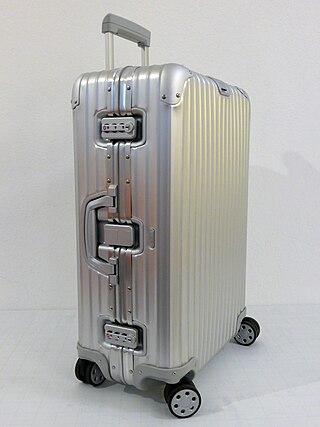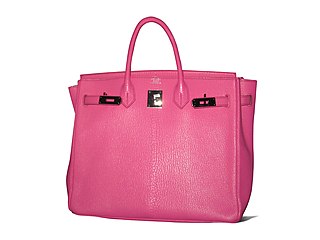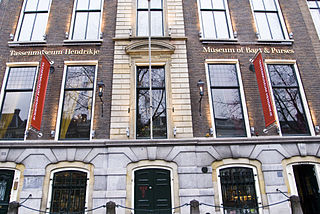
A suitcase is a form of baggage. It is a rectangular container with a handle and is typically used to carry one's clothes and other belongings while traveling. The first suitcases appeared in the late 19th century due to the increased popularity of mass tourism at the time and were meant to hold dress suits. They were originally made using heavier materials such as leather or steel, but, beginning in the 1930s, were constructed with more lightweight materials like plastic and cardboard.
Delvaux is a Belgian manufacturer of fine leather luxury goods founded in 1829 by Charles Delvaux. The company is the oldest fine leather luxury goods house in the world. Since 2021 the company has been owned by Richemont.

Louis Vuitton Malletier SAS, commonly known as Louis Vuitton, is a French luxury fashion house and company founded in 1854 by Louis Vuitton. The label's LV monogram appears on most of its products, ranging from luxury bags and leather goods to ready-to-wear, shoes, perfumes, watches, jewellery, accessories, sunglasses and books. Louis Vuitton is one of the world's leading international fashion houses. It sells its products through standalone boutiques, lease departments in high-end departmental stores, and through the e-commerce section of its website. Louis Vuitton merged with Moët Hennessy in 1987 to create LVMH, of which it is a subsidiary.

A trunk, also known as a travel trunk, is a large cuboid container designed to hold clothes and other personal belongings. They are most commonly used for extended periods away from home, such as for boarding school, or long trips abroad. Trunks are differentiated from chests by their more rugged construction due to their intended use as luggage, instead of the latter's pure storage.

Baggage or luggage consists of bags, cases, and containers which hold a traveler's personal articles while the traveler is in transit. A modern traveler can be expected to have packages containing clothing, toiletries, small possessions, trip necessities. On the return trip, travelers may have souvenirs and gifts. For some people, luggage and the style thereof is representative of the owner's wealth and status. Luggage is constructed to protect the items during travel either with a hard shell or a durable soft material. Luggage often has internal subdivisions or sections to aid in securing items. Handles are typically provided to facilitate carrying, and some luggage may have wheels and/or telescoping handles or leashes to make moving them easier.

A handbag, commonly known as a purse in North American English, is a handled medium-to-large bag used to carry personal items. It has also been called a pocketbook in parts of the U.S.

The Birkin bag is a tote bag introduced in 1984 by French luxury goods maker Hermès. Birkin bags are handmade from leather and are named after the English-French actress and singer Jane Birkin.

Dame Anya Susannah Hindmarch, is an English fashion accessories designer who founded an eponymous company, of which she is CEO. Hindmarch published her first book, If In Doubt Wash Your Hair in May 2021, a Sunday Times bestseller.

Longchamp is a French leather goods company, founded in Paris in 1948 by Jean Cassegrain. The company pioneered luxury leather-covered pipes before expanding into small leather goods. Longchamp debuted women's handbags in 1971, becoming one of France's leading leather goods makers. Today, the company designs and manufactures leather and canvas handbags, luggage, shoes, travel items, fashion accessories, and women's ready-to-wear. The house is privately owned and managed by the Cassegrain founding family and does business in 80 countries through around 1,500 retail outlets.

Asprey is a United Kingdom-based designer, manufacturer and retailer of jewellery, silverware, home goods, leather goods, timepieces, and books.

The Museum of Bags and Purses, was a museum devoted to the history of bags, purses, and their related accessories. Located in Amsterdam's historic central canal belt, the museum's collection included over 5,000 items dating back to the sixteenth-century.
Moynat is a Parisian trunkmaker, founded in Paris in 1849 by Octavie and François Coulembier. They collaborated with specialist Pauline Moynat in travel goods to open the company's first store at Avenue de l'Opera, France. The house participated in various World's Fairs.

Tanner Krolle is a manufacturer of leather goods based in London.
The so-called English trunk is a wicker trunk that was invented in England around 1839 by H.J. Cave. The trunk was invented as a means of making luggage lighter for railway travel. The trunk was originally used to transport linen, bedding, clothing and pique-niques.

Louis Vuitton was a French fashion designer and businessman. He was the founder of the Louis Vuitton brand of leather goods now owned by LVMH. Prior to this, he had been appointed as trunk-maker to Empress Eugénie de Montijo, wife of Napoleon III.

Au Départ, Ltd. is a Parisian trunkmaker founded in Paris in 1834. Au Départ is considered as one of four greatest French trunk-makers alongside Louis Vuitton, Goyard and Moynat.

G.W. Scott and Sons was a producer of fine wickerwork crafts, basketry, and luxury leather goods for over 300 years. Founded in 1661 in the city of London, England, in the United Kingdom, the company ceased production in 1967.
Lancel is a French Maison of luxury leather goods, founded in Paris in 1876 by Angèle and Alphonse Lancel and developed by their son Albert.
The House of Finnigans was a British luxury luggage and trunk maker established in 1830, originally in Manchester and later in New Bond Street in London. The House of Finnigans manufactured and produced a wide range of luxury products, including trunks, bags, fashion, jewellery, timepieces, and silverware.
Launer London is a British manufacturer of luxury handbags and other small leather goods founded in 1940 by Sam Launer, who emigrated to London from Czechoslovakia during the Second World War. The company first sold a handbag to a member of the British royal family in 1950 and subsequently was awarded a royal warrant by Queen Elizabeth II.













